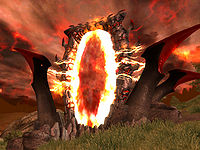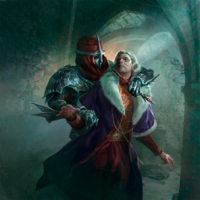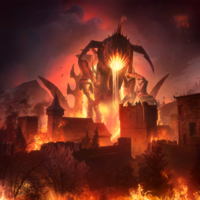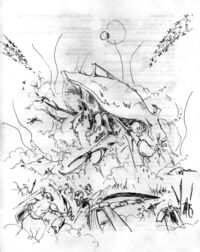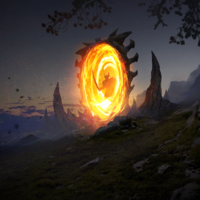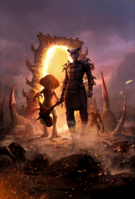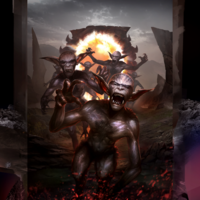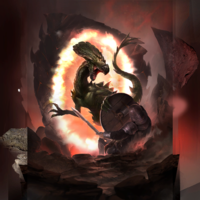Lore:Oblivion Crisis
| To meet our site's higher standard of quality, this article or section may require cleanup. The user who placed this here had the following concern: Needs references/links/tweaks to formatting. To leave a message about the cleanup for this article, please add it to this article's talk page. |
The Oblivion Crisis, also known as the Great Anguish,[1] was a total war between the Daedra and the population of Tamriel. It began with the assassination of Uriel Septim VII and all of his known heirs[2] in 3E 433.[3] Shortly afterward, Oblivion Gates to the Deadlands opened across Tamriel and Daedra poured out as the result of a fanatical cult of worshippers of Mehrunes Dagon known as the Mythic Dawn.[4] Widespread devastation and casualties resulted across entire provinces. The Daedra besieged Skyrim, and laid waste to the Old Holds.[5] In Black Marsh, the Hist called back many Argonians to fight off the Daedra. According to An-Xileel the Daedra were forced to close their Oblivion gates in Black Marsh due to Argonian counter invasion.[6] In Cyrodiil, the city of Kvatch was entirely destroyed.[7]
Adril Arano, a Second Councilor of Raven Rock in the late Fourth Era, claimed that the Empire pulled most of its forces out of Morrowind during the Crisis.[8] However, this contradicts the words of High Chancellor Ocato himself during the Crisis, who stated that Cyrodiil and cities such as Bruma were virtually defenseless precisely because he was both unable and unwilling to pull any troops out of the other provinces.[9] Indeed, the Imperial Province was left almost entirely to its own devices, and no foreign legions were ever found within Cyrodiil for the entirety of the Crisis or its immediate aftermath.[10] Still, a history of the Raven Rock colony records that the bulk of the Imperial Guard stationed there was recalled to Cyrodiil from the then-Nordic Solstheim, though the author's source for this matter are the Redoran Dunmer of the settlement.[11]
Although the Empire was near collapse, Uriel VII's illegitimate son, Martin Septim, ended the invasion with the help of a mysterious hero. The cost, however, was enormous. Martin, the last of the Septim bloodline, sacrificed himself and the Amulet of Kings to become an Avatar of Akatosh and cast Mehrunes Dagon back into Oblivion. This event marked the end of the Third Era.[12]
Prelude[edit]
Mehrunes Dagon long had desires upon Tamriel, starting in the Interregnum period. Initially Mehrunes Dagon had little interest in Mundus, as other Daedric Princes sought to expand their influence in the absence of the Dragonblood Emperor's maintaining Akatosh's Covenant. Molag Bal initially invaded Tamriel at this time with his attempted Planemeld, and then the Triad of Mephala, Nocturnal and Clavicus Vile attempted to gain influence on Nirn and bypass Sotha Sil's Coldharbour Compact. But Kinlady Estre dissatisfied with the tolerant direction the High Queen of the Aldmeri Dominion had taken made a pact with Mehrunes Dagon leading to his invasion of the Aldmeri Dominion, and Blackmarsh, but this plot was foiled by the Vestige. This may have been the start of his greater ambitions for Tamriel.
The Mythic Dawn has unclear origins, but may have been present since the time of Tiber Septim. They believed that Mundus was simply another plane of Oblivion, governed by the Daedric Prince Lohrkhan, murdered by the Eight Divines. They believed that the world was trapped in lies and illusion meant to prop up the rule of the Aedra, and that Mehrunes Dagon's true domain was Hope and Change, and that he would 'liberate' Mundus from the Aedra, granting his followers 'eternal paradise', which would manifest itself as a small plane of Oblivion.
It's believed that Mehrunes Dagon may have had a hand in the infamous Camoran Usurpers conquests in eastern Tamriel, who was known to use armies of Daedra and the Undead, but supposedly the Usurper lost favor with his 'Master' shortly before his defeat, falling back on the use of mortal armies and conventional trickery. Mankar Camoran claimed relation to this Camoran Usurper, supposedly being born to his mistress the same day as his defeat.
It's also thought that Mehrunes Dagon played an active role in the Imperial Simulacrum, when Imperial Battlemage Jagar Tharn impersonated the Emperor for ten years. Emperor Uriel Septim VII was banished to a portion of oblivion controlled by Mehrunes Dagon, who only remembered this time as a series of nightmares. This may also explain the series of provincial wars that came about in the Simulacrum from Tharn's incompetent ruling- that they were to perform some sort of right for the Prince of Destruction. Jagar Tharn also made a deal to give Mehrunes Dagon access to the Imperial Battlespire, which he invaded, which Tharn gained by removing powerful Battlemages that may have threatened his rule. During this time, Mehrunes Dagon was strengthening his hold of Oblivion, also invading the Soul Cairn and Shade Perilous, and recruiting several Seducers to his army, potentially in preparation for his invasion of Tamriel. Following the overthrow of Jagar Tharn by the Eternal Champion, the forces of the Empire hunted down several of Dagon's agents.
Major Battles[edit]
|
Aftermath[edit]
The Oblivion Crisis created a renewed fear of the Daedra, of dark magic, as well as magic in general, particularly in Skyrim which had a longstanding tradition of magical learning and practice. This paranoia towards magic saw the dissolution of the Mages Guild, which was replaced by the two institutions of the Synod and the College of Whispers, which is under Imperial control. The Vigilant of Stendarr were founded in response to the Oblivion Crisis to hunt any Daedra, or practitioners of the Dark Arts across Tamriel.[14] The Mythic Dawn responsible for the Oblivion Crisis were hunted down by numerous warrior groups, and were thoroughly eradicated, though there would be later attempts to rebuild the cult. One group was formed, known as the Keepers of the Razor, who sought out Mehrunes Dagger, artifact of the Daedric Prince of Destruction, who then broke the weapon into three pieces, passed along their descendants who would move to Skyrim to keep them out of the hands of potential cultists.
The death of Martin Septim marked the end of the Septim Dynasty, and the Third Era. While Mehrunes Dagon had failed to conquer Tamriel, the damage to the continent would greatly weaken the Empire. Most provinces in the Empire felt abandoned as Imperial Legions were unable to provide relief or defense in the Oblivion Crisis, stirring separatist sentiments. High Chancellor Ocato would become Potentate of the Empire, attempting to stabilize it. However soon Black Marsh would secede under the nationalist An-Xileel, the only province seemingly strengthened during the Oblivion Crisis, renaming the land as Argonia. Argonia would then take advantage of the chaos of the Red Year to invade Morrowind, weakening them further, which in turn would fuel anti-imperial sentiment who were unable to help during the crisis.
The assassination of Potentate Ocato in 4E 15 led to the start of the Stormcrown Interregnum, which ended when Titus Mede I, the founder of the Mede Dynasty, captured the Imperial City in 4E 22. During this chaos, Orsinium was sacked once again by High Rock and Hammerfell.
The Oblivion Crisis also helped propel the marginalized Thalmor of the Summerset Isles to new prominence, as they were instrumental in it's defense, and after the crisis was resolved took most of the credit. The Thalmor would later push to secede entirely from the Empire in 4E 22, and seized Valenwood in a coup in 4E 29 reforming the Aldmeri Dominion.
Gallery[edit]
Notes[edit]
- Similar invasions of Tamriel by Mehrunes Dagon include the attacks on Firsthold, Whisper Grove, and Blackwood in 2E 582.[15] Circa 4E 201, the reformed Mythic Dawn, led by a new prophet named Vonos, sought to bring about a new invasion via the Prophecy of the Dragonborn. The Last Dragonborn unwittingly helped the cult to open a new Oblivion Gate due to their unique connection to Akatosh. The Dragonborn ventured into Deadlands and slayed the invasion force's two heralds, delaying the invasion. The Vigil of Stendarr then wrested control of the Gate from the Mythic Dawn, and stood guard over it to ensure no Daedra came through from the other side.[16]
References[edit]
- ^ a b Rising Threat — Lathenil of Sunhold
- ^ Tutorial quest in Oblivion
- ^ The Oblivion Crisis — Praxis Sarcorum, Imperial Historian
- ^ Main Quest in Oblivion
- ^ Rumors in Oblivion
- ^ The Infernal City — Greg Keyes
- ^ a b Breaking the Siege of Kvatch and The Battle for Castle Kvatch quests in Oblivion
- ^ Adril Arano's dialogue in Dragonborn
- ^ Chancellor Ocato's dialogue in Oblivion
- ^ Events of Oblivion
- ^ a b History of Raven Rock, Vol. I — Lyrin Telleno
- ^ a b Light the Dragonfires quest in Oblivion
- ^ Defense of Bruma and Great Gate quests in Oblivion
- ^ Vigilant of Stendarr's dialogue in Skyrim
- ^ Events of ESO
- ^ Events of The Cause Creation in Skyrim
Note: The following references are considered to be unofficial sources. They are included to round off this article and may not be authoritative or conclusive.
- ^ The Fall of Ald'Ruhn — Michael Kirkbride
|
|||||||||||||||||
